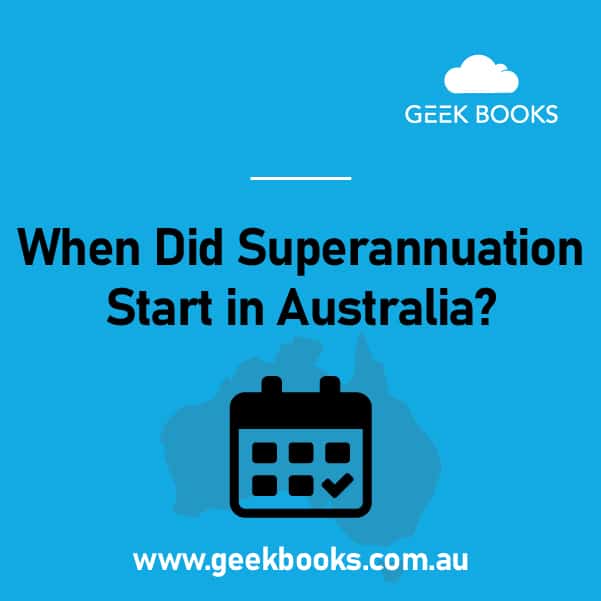Superannuation is so ingrained in the working Australian’s life that many of us have probably never stopped and really given it a second thought- especially if we’re a long way off from retirement age!
But let’s think about it now. Why?
Because superannuation is important! It allows you to accumulate savings throughout your career, providing financial security for a comfortable and sustainable retirement.
Superannuation in Australia has a rich history.
From its humble beginnings, the superannuation system has transformed into a vital component of our working lives.
But where did it all start? Why is superannuation compulsory, and how do voluntary contributions fit into the picture?
Does everyone have to pay superannuation?
We have the answers for you.
By unearthing the roots of this crucial financial structure, you’ll better understand its evolution and how it impacts all of us.
Let’s travel back in time to unwrap the answer to the first big question- when did superannuation start in Australia?
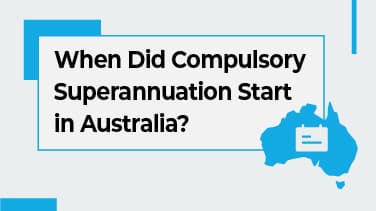
When Did Compulsory Superannuation Start in Australia?
Compulsory superannuation in Australia started with the introduction of the Superannuation Guarantee (SG) in 1992.
The SG was a government initiative designed to ensure that all workers in Australia, aside from certain exceptions, could accumulate savings for retirement.
Let’s look at a simplified timeline of the major developments in Australian superannuation:
- 1862: The first superannuation fund is established in Australia for public servants in Victoria.
- 1915: The first private sector superannuation fund is established by the Bank of New South Wales for its employees.
- 1983: Award superannuation begins, in which certain employees receive super contributions as part of industrial awards. These were for employees from largely unionised industries like banking, insurance, finance, and public sectors like government services and education. These superannuation contributions were considered an added benefit to the employees’ wages, and not all employees were entitled to them.
- 1985: The Australian government announces its intention to extend superannuation coverage through the award system.
- 1986: The Australian Conciliation and Arbitration Commission issues a national wage case decision endorsing superannuation as an employment condition. This decision sets the stage for superannuation to eventually become a widespread employee benefit.
- 1991: The Superannuation Guarantee (Administration) Act 1992 is passed, legislating compulsory employer contributions.
- 1992: The Superannuation Guarantee (SG) comes into effect on July 1, requiring employers to contribute to a super fund on behalf of their employees. The initial SG rate is set at 3% of an employee’s wages.
- 1993: The World Bank hails Australia’s ‘three-pillar’ approach to retirement income as a model of best practice globally. This system includes compulsory superannuation, the age pension, and voluntary retirement savings.
- 2002: The SG rate increases to 9%.
- 2005: Choice of fund reforms allow many Australian workers to choose the super fund to which their super guarantee contributions are paid.
- 2014: Australian employees who have not selected a specific superannuation fund start having their SG contributions directed into a default MySuper fund, as determined by their employers.
- 2023: The SG rate reaches 11%, continuing its gradual increase towards the target of 12% by 2025.
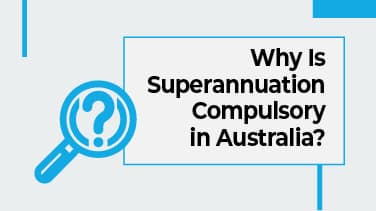
Why Is Superannuation Compulsory in Australia?
Superannuation is compulsory in Australia to ensure that every working individual can have a secure and comfortable retirement.
The idea is that while you’re working, you’re steadily saving for your later years.
When you retire, you won’t have a regular income from work as you used to, so these superannuation savings become incredibly important.
They will help cover essential living costs and medical expenses.
These savings also mean you can maintain a lifestyle similar to what you had while working.
Compulsory superannuation for eligible workers in Australia aims for self-funded retirement, reducing people’s reliance on the Age Pension and ultimately taking pressure off the government’s public funding.
So superannuation basically means a better and more secure financial future for everyone.
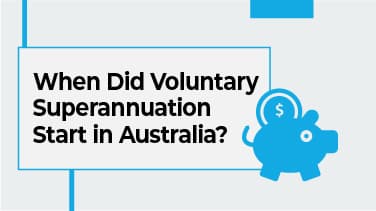
When Did Voluntary Superannuation Start in Australia?
Voluntary superannuation contributions are extra payments you can choose to put into your superannuation fund in addition to the compulsory contributions made by your employer.
These could be from your after-tax income (also known as non-concessional contributions) or your before-tax income, such as salary sacrificing (concessional contributions).
These voluntary contributions can help grow your retirement savings more quickly.
Voluntary superannuation in Australia dates back to 1862, when the first superannuation fund was established for public servants in Victoria.
It was a non-compulsory system that workers could choose to contribute to, making it a form of voluntary superannuation.
However, this form of superannuation was not broadly accessible and only covered a small proportion of the workforce, often in specific sectors such as banking, finance, and public service.
Widespread voluntary superannuation for all workers didn’t really come into play until the late 20th century.
Even then, it was often tied to certain conditions of employment or specific industries.
It wasn’t until the introduction of the Superannuation Guarantee in 1992 that superannuation became a universal aspect of employment in Australia.
Since then, voluntary contributions above the compulsory level have been an option for those wishing to boost their retirement savings.
July 1, 2005, marks a significant milestone in Australia’s superannuation history.
On this date, the ‘Choice of Fund’ reforms came into effect. Before these reforms, most workers had little control over where their superannuation contributions were invested.
Typically, employers or the terms of the industrial award determined the superannuation fund.
But with the implementation of the ‘Choice of Fund’ reforms, many employees gained the ability to choose the superannuation fund into which their Superannuation Guarantee contributions would be paid.
This increased flexibility meant that individuals could select a fund that best suited their retirement goals and risk tolerance.
This development also indirectly encouraged voluntary superannuation contributions.
With the power to choose their fund, employees had more control and, therefore, more engagement with their superannuation.
As a result, more Australians started making voluntary contributions to maximise their retirement savings.
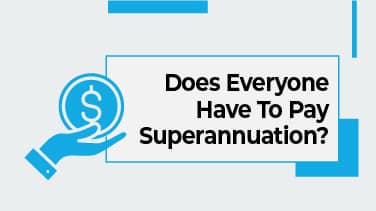
Does Everyone Have To Pay Superannuation?
Under Australia’s Superannuation Guarantee system, employers are obligated to contribute an amount equal to 11% of an employee’s regular working hours’ earnings into their superannuation fund, given certain conditions.
This applies if the employee is over 18 years old or under 18 but works more than 30 hours per week.
These rules aren’t restricted to full-time workers. Employers must contribute to super for part-time and casual workers, provided they meet the eligibility criteria.
This allows individuals to accumulate a substantial nest egg for their retirement over their working life, regardless of their employment type.
Even temporary residents working in Australia can be entitled to receive superannuation contributions from their employers.
For example, that includes backpackers and working holidayers who earn more than $450 per month before tax and meet other eligibility requirements.
Although temporary residents can accrue superannuation, accessing these funds is usually only possible after leaving Australia permanently, a process referred to as a Departing Australia Superannuation Payment (DASP).
Employers must pay compulsory contributions to their employees’ chosen superannuation funds at least every quarter.
However, not all employers are required to make superannuation payments.
There are some exceptions based on the following factors:
- Age and income: If an employee is under 18 and works less than 30 hours a week or earns less than $450 (before tax) in a calendar month, the employer is not obligated to make superannuation contributions for them.
- Type of employment: Non-resident employees who work for an Australian company but carry out their work overseas are exempt from receiving superannuation contributions. Foreign executives holding certain visas or entry permits who visit Australia temporarily for work purposes while maintaining their primary residence in another country are also exempt.
- Private or domestic work: Superannuation contributions are generally not required for private or domestic workers (like nannies or housekeepers) who work less than 30 hours per week.
Employers and employees must be aware of these exceptions to fulfil their legal obligations and receive their entitled benefits.
For more information, visit the Australian Government Fair Work Ombudsman website.
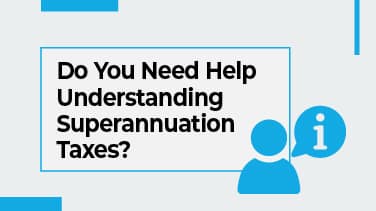
Do You Need Help Understanding Superannuation Taxes?
When did superannuation start in Australia?
The superannuation system as we know it today in Australia began in 1992 with the introduction of the Superannuation Guarantee, which made it compulsory for employers to contribute to superannuation on behalf of their employees.
For employees, these contributions to their super fund mean they are consistently saving for retirement.
As for business owners, contributing to their own super fund provides them with a tax-effective way to save for retirement.
Plus, the ability to make voluntary contributions, both concessional and non-concessional, allows everyone to bolster their retirement savings according to their financial capability.
But along with superannuation contributions come superannuation taxes.
As a business owner, you must correctly calculate and make the mandatory Superannuation Guarantee contributions for your employees, understand any tax benefits you may be entitled to, and stay compliant with Australia’s ever-changing superannuation and tax laws.
Incorrect handling of superannuation responsibilities can result in penalties, so expert assistance is invaluable.
That’s where we come in. Navigating the maze of superannuation taxes can be daunting, especially when your focus is on running your business.
At GeekBooks, we specialise in providing Superannuation Accounting and Financial Services tailored for business owners like you.
Superannuation is something you want to get right- for you and your employees.
We take the stress out of the superannuation process by helping you accurately calculate and pay your employees super on time.
Let us help you prepare for a secure financial future.
Complete our online booking form or call 02 9158 3591 for a free bookkeeping quote.


